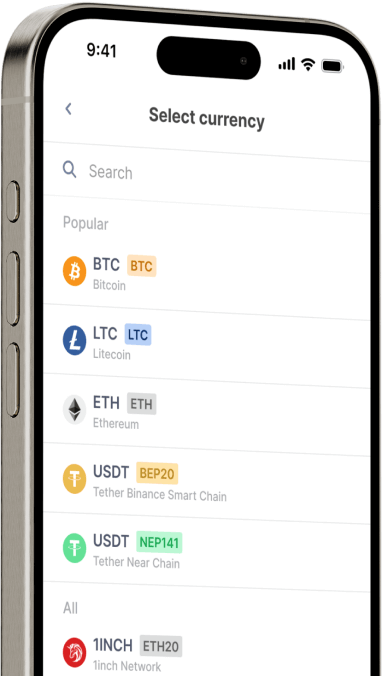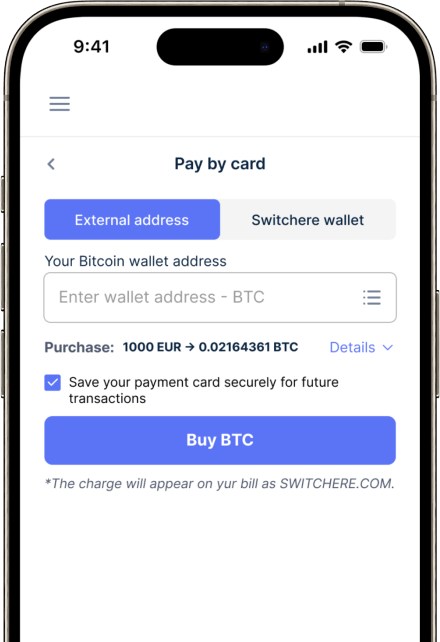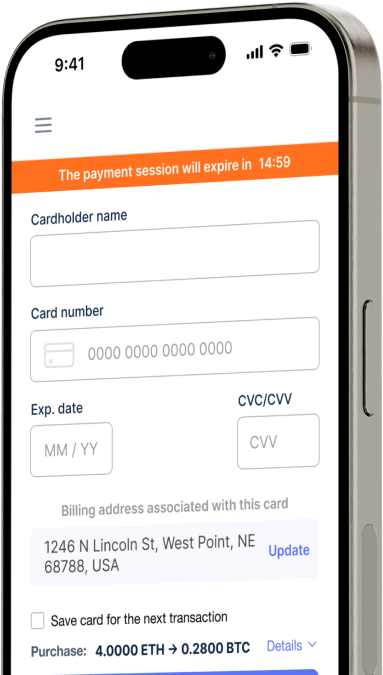Конвертуйте
Azerbaijan Manat (AZN) на Curve DAO Token (CRV) миттєво
Купуйте Curve DAO Token (CRV) за допомогою Azerbaijan Manat (AZN) легко на Switchere і отримуйте вигоду від швидких і безпечних транзакцій.
Близько
Curve DAO Token (CRV)
Curve DAO Token (CRV) - це токен утиліти та управління для Curve Finance, провідної децентралізованої біржі (DEX) та автоматизованого маркет-мейкера (AMM). Запущена в основному на блокчейні Ethereum, Curve Finance спеціалізується на забезпеченні надзвичайно ефективної торгівлі та глибокої ліквідності для стейблкоінів та інших прив'язаних активів, таких як обгорнуті варіанти біткоїнів, використовуючи нові алгоритми кривої зв'язку, розроблені для мінімізації прослизання. Це робить його наріжним каменем екосистеми децентралізованих фінансів (DeFi), особливо для операцій, що вимагають стабільних обмінів активами в рамках різних додатків і стратегій DeFi.
Основна технологія Curve використовує смарт-контракти, написані переважно на Vyper для безпеки і простоти, для створення висококонцентрованих пулів ліквідності. Токени CRV займають центральне місце в токеноміці платформи; власники можуть вкладати CRV, блокуючи їх для отримання CRV з обмеженим правом голосу (veCRV). Цей veCRV надає власникам право голосу в Curve DAO, щоб впливати на параметри протоколу, в тому числі спрямовувати емісію CRV в певні пули ліквідності за допомогою вагових коефіцієнтів. Крім того, власники veCRV мають право на частку торговельної комісії протоколу і можуть збільшити свою винагороду, надаючи ліквідність. Його роль у забезпеченні ліквідності стейблкоінів та конкурентна динаміка навколо управління ним (яку часто називають "війною кривих") підкреслюють його значення як базового цифрового активу в ланцюжку та компонента інфраструктури Web3.
Купуйте інші 150+ криптовалют за допомогою Azerbaijan Manat (AZN)
Інші монети за Azerbaijan Manat (AZN)
-
AZN на ZRX
-
AZN на 1INCH
-
AZN на AAVE
-
AZN на ACH
-
AZN на ALGO
-
AZN на TLM
-
AZN на ANKR
-
AZN на APE
-
AZN на NFT
-
AZN на API3
-
AZN на APT
-
AZN на ARPA
-
AZN на AUDIO
-
AZN на AVAX
-
AZN на AVAX
-
AZN на AXS
-
AZN на BADGER
-
AZN на BAL
-
AZN на BNT
-
AZN на BAT
-
AZN на BNB
-
AZN на BSW
-
AZN на BSV
-
AZN на BLUR
-
AZN на BONE
-
AZN на CTSI
-
AZN на CELR
-
AZN на CELO
-
AZN на CEL
-
AZN на LINK
-
AZN на CHZ
-
AZN на CHR
-
AZN на C98
-
AZN на COMP
-
AZN на CFX
-
AZN на PEOPLE
-
AZN на CVX
-
AZN на ATOM
-
AZN на CTC
-
AZN на CRV
-
AZN на DAI
-
AZN на DASH
-
AZN на MANA
-
AZN на DENT
-
AZN на DGB
-
AZN на DYDX
-
AZN на XEC
-
AZN на EOS
-
AZN на ETC
-
AZN на ENS
-
AZN на ETHW
-
AZN на FET
-
AZN на FIL
-
AZN на FLOKI
-
AZN на GALA
-
AZN на GNO
-
AZN на ONE
-
AZN на HBAR
-
AZN на HOT
-
AZN на HOOK
-
AZN на ICX
-
AZN на ILV
-
AZN на IMX
-
AZN на INJ
-
AZN на ICP
-
AZN на IOST
-
AZN на IOTX
-
AZN на JASMY
-
AZN на JST
-
AZN на KAVA
-
AZN на KCS
-
AZN на KSM
-
AZN на KNC
-
AZN на LDO
-
AZN на LQTY
-
AZN на LPT
-
AZN на LOOKS
-
AZN на LRC
-
AZN на LUNA
-
AZN на MKR
-
AZN на MASK
-
AZN на EGLD
-
AZN на ALICE
-
AZN на NEAR
-
AZN на XEM
-
AZN на NEXO
-
AZN на NOT
-
AZN на NMR
-
AZN на OKB
-
AZN на OMG
-
AZN на ONT
-
AZN на EDU
-
AZN на OP
-
AZN на OGN
-
AZN на CAKE
-
AZN на PAXG
-
AZN на PENDLE
-
AZN на DOT
-
AZN на POL
-
AZN на QTUM
-
AZN на QNT
-
AZN на RDNT
-
AZN на XRD
-
AZN на RVN
-
AZN на REN
-
AZN на RSR
-
AZN на RLC
-
AZN на RPL
-
AZN на SFP
-
AZN на SHIB
-
AZN на SKL
-
AZN на SXP
-
AZN на STND
-
AZN на STG
-
AZN на XLM
-
AZN на GMT
-
AZN на STORJ
-
AZN на STMX
-
AZN на SUSHI
-
AZN на SNX
-
AZN на USDT (Polygon)
-
AZN на USDT (AVAC)
-
AZN на USDT (BEP20)
-
AZN на USDT (ERC20)
-
AZN на USDT (SPL)
-
AZN на USDT (NEP141)
-
AZN на USDT (FA2)
-
AZN на USDT (TRC20)
-
AZN на USDT (JETTON)
-
AZN на XTZ
-
AZN на GRT
-
AZN на SAND
-
AZN на TFUEL
-
AZN на THETA
-
AZN на RUNE
-
AZN на TON
-
AZN на TUSD (BEP20)
-
AZN на TUSD (TRC20)
-
AZN на TWT
-
AZN на UOS
-
AZN на UMA
-
AZN на UNI
-
AZN на USDC (Polygon)
-
AZN на USDC (SPL)
-
AZN на USDC (OP)
-
AZN на USDC (BEP20)
-
AZN на USDC (AVAC)
-
AZN на USDC (ARB)
-
AZN на USDC (ERC20)
-
AZN на VET
-
AZN на VRA
-
AZN на WAXP
-
AZN на WOO
-
AZN на WLD
-
AZN на WBTC
-
AZN на WMINIMA
-
AZN на XDC
-
AZN на YFI
-
AZN на YGG
-
AZN на ZIL
Як купити Curve DAO Token (CRV)?
Поширені запитання
-
Що таке торгова пара AZN/CRV і в чому її значення?
Пара AZN/CRV представляє обмінний курс між азербайджанським манатом (AZN), національною фіатною валютою, та токеном Curve DAO (CRV). Її значення полягає у створенні фіатного шлюзу, хоча й рідкісного, з конкретної місцевої економіки безпосередньо в ключовий компонент екосистеми децентралізованих фінансів (DeFi). CRV є токеном управління для Curve Finance, великого протоколу автоматизованого маркет-мейкера (AMM), що зосереджений на забезпеченні глибокої ліквідності для стейблкоїнів та інших подібних активів. Торгівля цією парою дозволяє безпосередньо оцінювати цей важливий токен управління DeFi в AZN.
-
Які основні функції токена CRV у протоколі Curve Finance?
Токен CRV має три основні функції в межах Curve DAO. 1) Управління: власники можуть заблокувати свої CRV, щоб отримати veCRV (vote-escrowed CRV), що дозволяє їм брати участь у голосуваннях DAO щодо оновлень протоколу та змін параметрів. 2) Стейкінг: власники veCRV отримують частку торгових комісій протоколу. 3) Збільшення винагород: постачальники ліквідності можуть заблокувати CRV, щоб збільшити винагороди, які вони отримують за надання ліквідності в пули Curve. Ця модель токеноміки стимулює довгострокове утримання та активну участь в екосистемі.
-
Чому ринкова ліквідність є критичним фактором для пари AZN/CRV?
Ринкова ліквідність є вирішальною для будь-якої торгової пари, але особливо для такої нішевої, як AZN/CRV. Низька ліквідність означає, що покупців і продавців мало, що призводить до широкого спреду між ціною купівлі та продажу та високого прослизання ціни на великих ордерах. Це робить транзакції дорожчими та неефективними. Хоча сам протокол Curve Finance розроблений для створення високоліквідних пулів для активів, таких як стейблкоїни, пара для входу (AZN/CRV) на централізованій біржі, ймовірно, матиме дуже низький обсяг торгів, що вимагатиме від трейдерів обережності з розміром ордерів, щоб уникнути невигідних цін виконання.
-
Який найпоширеніший спосіб купити CRV за азербайджанські манати (AZN)?
Прямий ринок AZN/CRV є надзвичайно рідкісним. Найбільш практичний метод включає двокроковий процес. Спочатку скористайтеся місцевою криптовалютною біржею або P2P-платформою, яка приймає AZN через банківський переказ, щоб придбати основну криптовалюту, таку як Bitcoin (BTC) або стейблкоїн (наприклад, USDT). По-друге, переведіть цей цифровий актив на глобальну біржу, де є лістинг CRV. На цій платформі ви зможете обміняти свої BTC або USDT на CRV. Ця багатоетапна стратегія фіатного шлюзу є поширеною для придбання менш ліквідних альткоїнів.
-
Які види комісій стягуються при конвертації AZN в CRV?
При конвертації AZN в CRV через типовий багатоетапний процес ви зіткнетеся з кількома видами комісій. 1) Комісії за депозит/покупку: початкова платформа може стягувати комісію за депозит AZN або за транзакцію з фіату в криптовалюту. 2) Торгові комісії біржі: як перша біржа (з AZN в BTC/USDT), так і друга (з BTC/USDT в CRV) стягуватимуть торгову комісію, зазвичай невеликий відсоток від вартості транзакції. 3) Комісії мережі блокчейн: ви сплатите мережеву комісію (наприклад, плату за газ в Ethereum для токена ERC-20 CRV) за переказ активів між біржами та на ваш особистий цифровий гаманець.
-
Які найкращі практики безпеки для зберігання токенів CRV після покупки?
Після придбання CRV вкрай важливо перевести їх з біржі на безпечний, самостійно керований цифровий гаманець, де ви контролюєте приватні ключі. Для максимальної безпеки використовуйте апаратний гаманець (холодне сховище), такий як Ledger або Trezor. Оскільки CRV є токеном ERC-20, будь-який гаманець, сумісний з Ethereum, підійде. Завжди створюйте резервну копію вашої сід-фрази в автономному режимі та ніколи не діліться нею. Увімкніть двофакторну автентифікацію (2FA) на всіх облікових записах бірж, які використовувалися в процесі. При взаємодії з протоколами DeFi, такими як Curve, завжди перевіряйте URL-адресу, щоб уникнути фішингових афер.




